2013-17
Exhibitions at the Innovation Centre
Having moved to the Innovation Centre, CCANW was able to show exhibitions in its foyer and the area adjacent to its café. This was something that appealed to the Centre and the rent of our office and store was reduced on condition that exhibitions changed 3-4 times a year.
Image: Offices of the Innovation Centre. Photo Martyn Windsor.
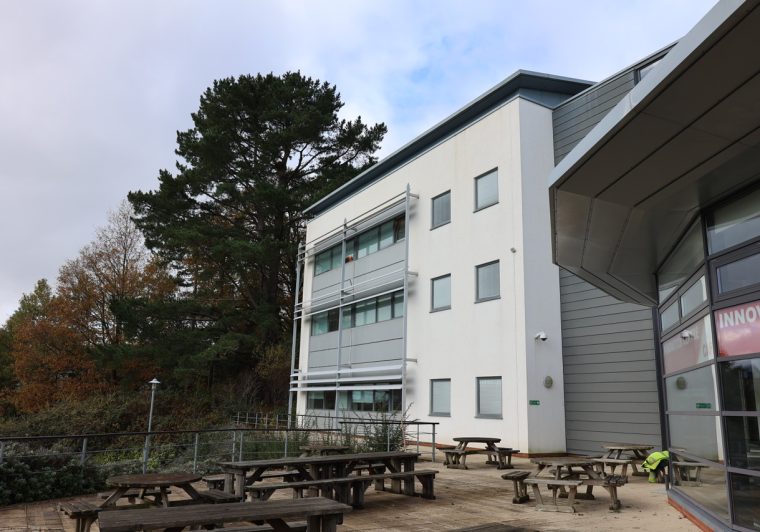
Having met by chance at the Visual Arts South West (VASW) conference in November 2013, Martyn Windsor joined us at the start of 2014, initially as an intern, then being paid one day a week. Martyn was an arts graduate of Falmouth University seeking to develop a career in curation.
With the technical support of Rolfe Mooney, Martyn went on to curate exhibitions at the Innovation Centre, as well as the touring and installation of the Soil Culture: Young Shoots exhibitions, the production of the Soil Culture publication, e-bulletins and working with CCANW during its period at Dartington. Gemma Baal left us in December 2014 and Kay Walker took over as Finance Officer for approximately one year.
The 15 exhibitions continued until 2017 and were generally open during weekdays 8.30am-5.30pm, being launched with a talk and refreshments around 5-7pm. The programme was advertised through Mailchimp newsletters to a database of over 3,000 subscribers.
10 May-9 July 2013
Lived Abstractions: Catrin Webster
The works in this exhibition were the outcome of artist Catrin Webster’s Leverhulme Trust funded residency in the Department of Geography at the University of Exeter, 2012-13. Over 20 original artworks by Catrin comprised the majority of the show; in addition there were works on show by Dr John Wylie, a cultural geographer based at Exeter who has been collaborating with Catrin through the course of the residency. Two larger images in the exhibition were part of a collaborative initiative by staff and children connected with the geography department, done under Catrin’s direction.
16 July-4 October 2013
Peter Randall-Page: Drawings and Prints
The sculptor Peter Randall-Page is noted for his stone carving and fascination with the complex relationship between geometry and biology. As a prelude to his major exhibitions at Peninsula Arts and Plymouth City Museum and Art Gallery in January 2014, and Thelma Hulbert Gallery, Honiton in May 2014, we showed a selection of his botanical drawings and prints made 1994-2000. Peter was awarded an Honorary Doctorate by the University in 1999 and it purchased four linocuts from the exhibition for its Collection.
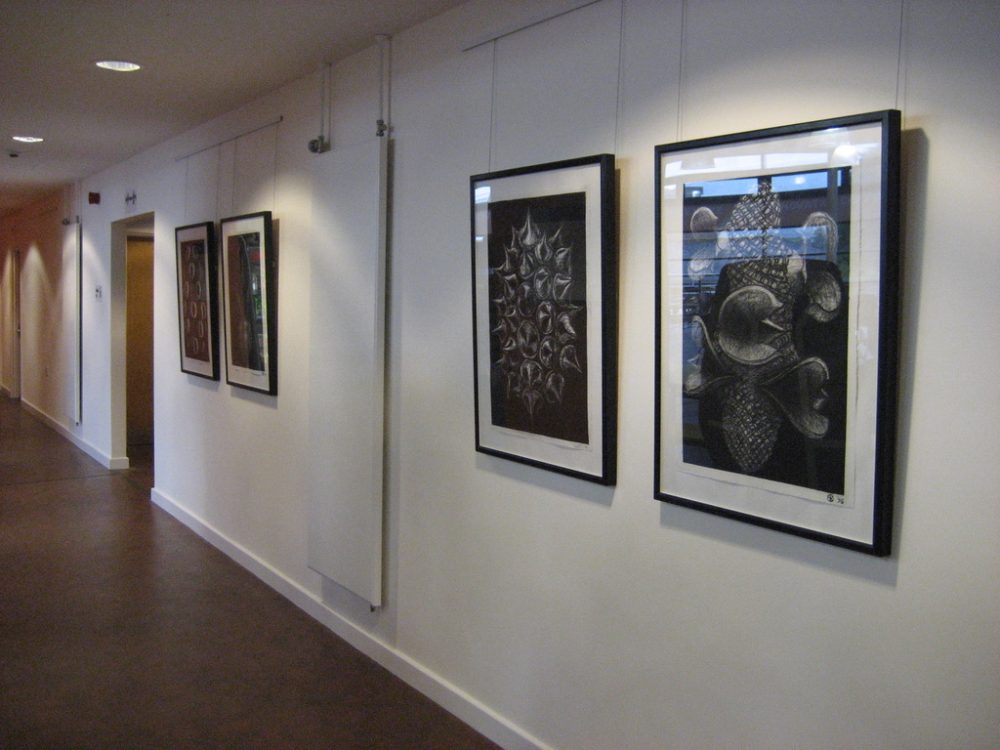
16 October-20 December 2013
A Taste of Soil Culture
In the lead up to a fundraising auction to support Soil Culture residencies, a ‘taster’ exhibition of work by Sandra Masterson, Pete Ward and Daro Montag was shown, with a talk on the project on 22 October.
The fundraising auction for the Soil Culture artist residencies was held on 3 December, to which forty artists generously donated work. Works could also be viewed online or at the Innovation Centre on 2 and 3 December. Thanks to Nic Saintey from Bearnes Hampton & Littlewood, the Innovation Centre and University for their support.
13 February-25 April 2014
John Curno: The Dartmoor Photographs 2002-13
Exhibition organised by Fotonow, Plymouth then shown by CCANW at the Create centre, Bristol. John Curno was born in Plymouth in 1949, moving to York in 1977 where the Impressions Gallery commissioned him to photograph the North York Moors. He returned to Devon in 1994 where he produced a notable series of photographs of Exeter and Dartmoor. In 2002 he was commissioned by Aune Head Arts to produce work for an exhibition, Dartmoor Sensing. His photographs were reproduced in a major monograph It’s About Time, published by Fotonow in 2012.
Part of John Curno exhibition. Photo Martyn Windsor
9 May-8 August 2014
Two Printmakers: Catherine Cartwright and Alison Savic
Both artists worked at Exeter’s Double Elephant Print Workshop, where Catherine was a Director. Her process of drypoint-collagraph explored human rights stories around the world through the destruction of built environments. Alison’s linocuts, drypoints and monoprints featured several of the buildings of the University.
5 September-7 November 2014
The Trembling Grass
The Trembling Grass was a mixed-media exhibition curated by Elizabeth-Jane Burnett that highlighted conflicts between nature and humankind caused by climate change and the depletion of natural resources. The title came from a line in a John Clare poem and the exhibition was displayed on the 150th anniversary year of the poet’s death. Part of the Extreme Imagination Festival.

Panel by Elizabeth-Jane Burnett
20 November 2014-21 January 2015
WILD WOOD: Fern Leigh Albert
Fern Leigh Albert became a member of the low-impact, off-grid Steward Community Woodland in 2013, situated in a 32 acre woodland on the edge of Dartmoor National Park. Fern documented her time in the community, living among twelve adults and seven children in self-built structures. This exhibition showcased new works by Fern highlighting a less romanticised connection with nature and a step towards voluntary simple living.
General views of Wild Wood exhibition. Photos Martyn Windsor
23 January-16 April 2015
Oliver Raymond-Barker
CCANW presented three distinctive yet intertwining projects from photographer Oliver Raymond-Barker, including an original look at Natural Alchemy; a project produced as a Creative Affiliate at the University of Exeter’s Environment and Sustainability Institute during 2013-14. Oliver’s work encompassed photography in its broadest sense, working with the raw potential of light and the mechanism of taking pictures.
17 April-16 July 2015
Parish Maps: Reflecting on the Legacy
The University of Exeter holds the archive of the influential arts and environment charity, Common Ground based in Dorset, spanning 30 years of their work in community conservation and environmental education. The exhibition focussed on their influential Parish Maps project and was accompanied by a short talk by members of the Humanities and Social Sciences research group on place and identity, and an academic workshop and roundtable discussion on community mapping. Supported by a Bridging the Gap award from the University.
General views of Parish Maps exhibition. Photos Martyn Windsor
22 October 2015-26 February 2016
COMPLICIT GEOGRAPHIES: Jeannette Unite
Jeannette Unite’s installation commemorated the 200 year anniversary of William ‘Strata’ Smith’s 1815 geological soil map of England. The paintings incorporated embedded text from Smith’s archive at Oxford University and were made with the very minerals that he described in this pioneering strata map.
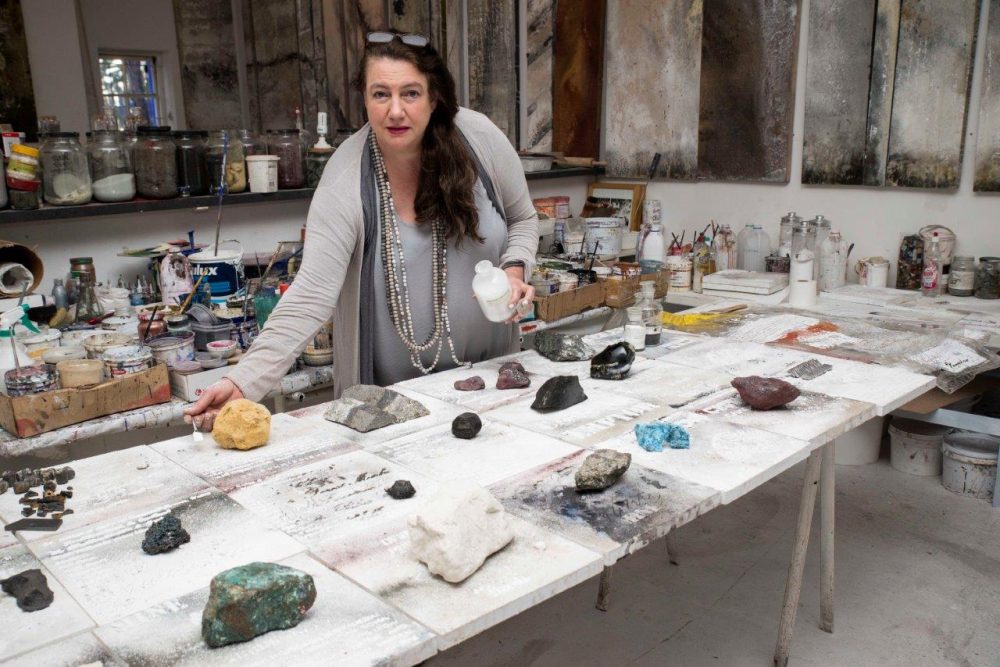
For Jeannette, the black coal from Wales, the tin from Cornwall and white chalk from Dover and iron, tin, lead, zinc, copper and even fossils, referenced Britain’s geology, geography and politics, as well as social and industrial history on a globalised scale.
1 March-26 May 2016
Susanna Bauer ‘Leaf Works’
Susanna Bauer’s leaf works paid homage to nature as well as holding up a mirror to the viewer. Mainly constructed with dry leaves and cotton yarn, the pieces held a fine balance of fragility and strength reflecting individual stories and connections. The artist endeavoured to slow us down and open our eyes to the small detail and the preciousness of the world that surrounds us.
General views of Susanna Bauer exhibition. Photos Martyn Windsor and Susanna Bauer.
31 May-2 September 2016
Stephen Park
This series of drawings was the outlet for unresolved and fragmented activity that originated in sketch books. They began as an endless series of designs with each motif having no particular brief other than to become something that might look purposeful as a rubber stamp.
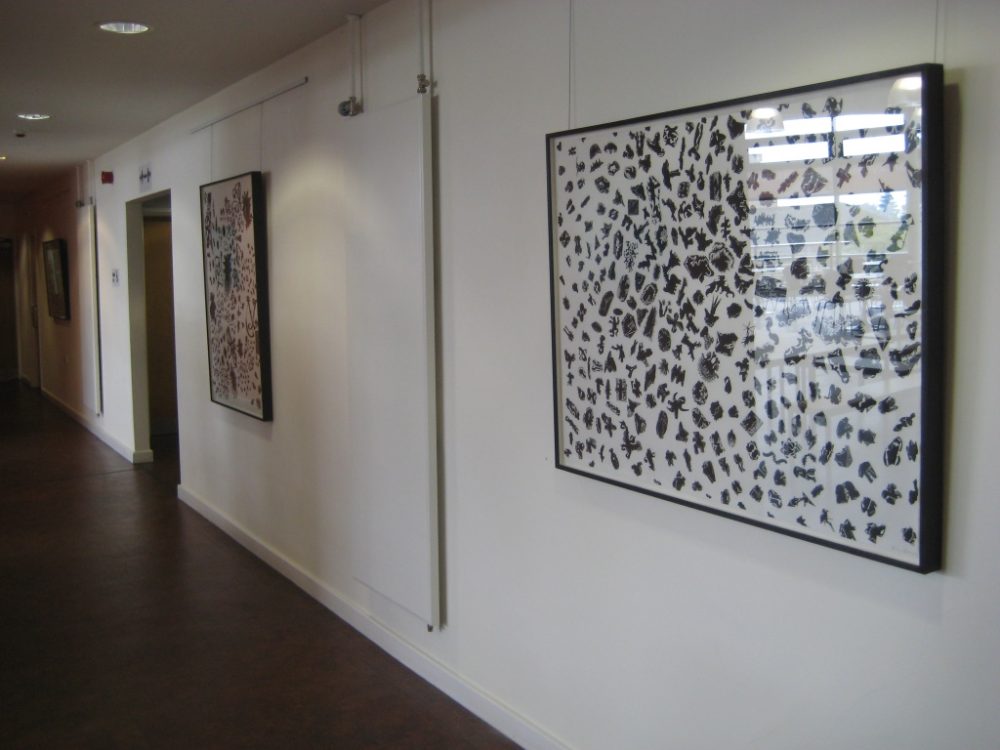
The preponderance of ‘biomorphic’ shapes was not primarily an aesthetic decision, although Stephen consciously decided not to exclude them. He was aware of a heavy reliance upon bilateral symmetry, which he believes has to do with efficiency in his drawings as it is in nature. If one side of a shape is satisfying it is twice the effort to design the other side from scratch than it is to make both sides the same. Article in the Moorlander newspaper.
Article in the Moorlander newspaper
19 September-23 December 2016
Simon Ryder: Bedrock & Paradox
Simon Ryder showed a series of large chalk drawings Giants of Albion which were the first chapter of a new project focussing on the geology of chalk and how it has influenced our identity as an island nation. To accompany these chalk drawings, Simon offered two other geological-based series, Clay to the Power of Ten and Pseudomorph Probes, each of which looked deep into the ground beneath our feet in search of new meanings. All three revealed how Simon used contemporary technologies to visualise underlying structures in order to open them to new interpretations.
From the Giants of Albion series
See more: General views of Simon Rider exhibition. Photos Martyn Windsor
16 January-28 April 2017
Land Art Generator Initiative (LAGI)
Since 2010, LAGI had held four idea-based competitions, bringing together teams to develop ideas for aesthetic solutions to renewable energy for sites in the UAE, New York City, Copenhagen and California. Between 2013-16 they worked with ecoartscotland and other Scottish partners on a design competition to develop a proposal for a site on Dundas Hill in Glasgow. The winning submission Wind Forest was designed by Dalziel + Scullion, Qmulus Ltd., Yeadon Space Agency and ZM Architecture. The exhibition documented this and other international competitions and was organised by ecoartscotland.
General views of LAGI exhibition. Photos Martyn Windsor
4 July-16 November 2017
Richard Rochester
Richard Rochester’s large-scale drawings of un-idealised British landscape sought to entice viewers through virtual ‘portals’ into wilderness. The scale of the drawing was considered critical to help produce a sense of immersion in the scenes portrayed. Whilst there was an interest in some of the ideas contained in biophilia hypothesis, Richard was also interested in our deep-seated instincts to assess landscapes from the perspective of survivability. He believed that the instincts developed over millennia to enable humans to survive in pre-modern times were still contained within all of us and his work aimed to stimulate some of the natural responses we feel when faced with an unfamiliar habitat.
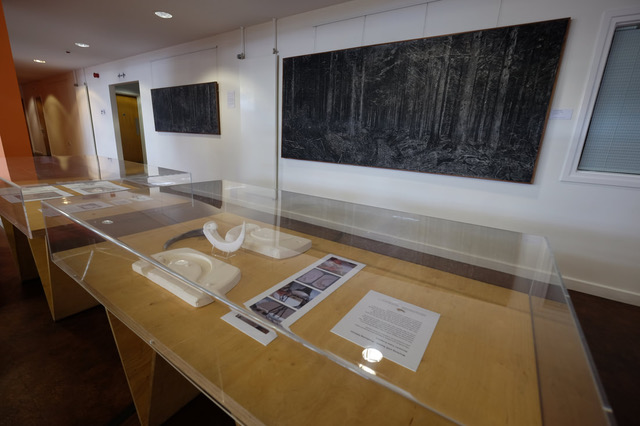
Next Page
art.earth
